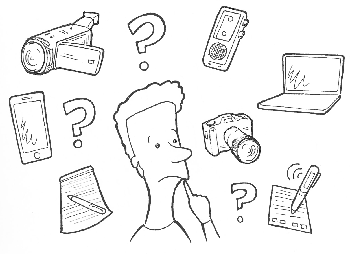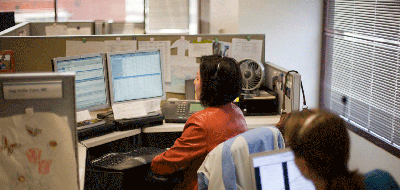Authors: Lauren Chapman Ruiz
Posted: Sun, February 23, 2014 - 5:32:11

How you choose to conduct and capture your research will greatly impact your outcomes, and ultimately your client outcomes. I’m going to highlight a variety of research-capturing tools, and then I’ll have a future post about how to effectively videotape research. Both the type of research you’re conducting and its purpose will help you decide which capture method is best.
Before we begin, I wouldn’t recommend going into research alone—you will struggle to document while maintaining a conversation. A good structure is to have a moderator and a note taker, that way one practitioner can focus on conversing with the participant, while the other focuses on capturing what is occurring.
Note-taking
Your options here are to take notes by hand, or to capture on a device such as a tablet or laptop. If you’re taking notes by hand, then you need to make sure you can return to those notes and understand what they mean. This will rely heavily on your memory when you spend time typing up your notes. On the flipside, your participants will likely be very open to speaking freely, knowing his or her voice and image aren’t being captured.
If you choose to type into a tablet or laptop, you will cut down the time of typing your notes later, but you’ve now introduced technology into your research encounter. If it’s important to have detailed, word-for-word notes, then transcribing with a laptop in the interview can be highly successful, and time-saving. The best practice here is to have the note taker remain in the background, quietly typing on a small laptop. He or she is tucked away to minimize distraction, keeping the interview focused on the moderator/participant conversation.
Audio recording

Audio recording is minimal in its invasiveness, and provides a word-for-word backup of everything you heard. It’s a safety net for your written notes or your memory—and a way to verify that what you captured is correct. If you’re trying to capture a complex process, you can reference the audio to ensure it’s correct. Audio can be provided to your stakeholders, and can be used to pull out compelling clips, allowing them to hear the support for your findings. There are a range of devices that can be used to record, from small pocket recorders to iPhone apps such as Voice Record Pro or iRecorder.
Make sure you don’t cross any ethical boundaries with audio recording—always inform your participants if you’re recording, and let them know what will happen to the information. This should be done in the form of a consent form prior to starting the interview.
Note-taking with audio recording
A research tool that captures word-for-word discussions and minimizes distraction is the Livescribe pen. This lovely piece of technology appears to be good old-fashioned paper and pen, but it is actually recording all audio to the pen and codifying it to the paper. Tap the pen to a sentence in your notes, and it will play exactly what was said in that same moment. It will also send a video of your notes, recorded stroke by stroke, with audio included, to your computer via Bluetooth. If you’re using a tablet, programs such as Microsoft OneNote and AudioNote will capture audio while you type or sketch with a stylus.
Screen capture with participants

In the case of usability research, you’re trying to capture a variety of actions occurring at the same time. You want to see where a participant clicks or touches on the user interface, you want to capture what pathways they take through the system, along with what they’re saying and their facial reactions. That’s a lot to manage. Luckily for us, there are some handy tools such as Silverback or Morae, which record the device screen, highlight clicks, and record the participant with audio.
Unfortunately, for mobile usability, capturing gets more difficult. There are some apps that let you record the device screen, such as Reflector, but you don’t get the taps or swipes. If you jailbreak the phone, Cydia has applications that will record the user actions. Another option with which I’ve had success is building a mobile camera mount (external camera rig) to capture the participant’s actions, but you will then have a clearly visible mount.
Video recording
When conducting research in context, you’re gathering more than just what is said; you’re also gathering critical observations about the space around the participant, the participant’s behavior, the programs that are used, the forms completed, the tools used, the sticky notes with reminders, and the “duct tape” (fixes and workarounds people makes for themselves). In this environment, visuals are incredibly important. As the famous anthropologist Margaret Mead said:
“What people say, what people do, and what they say they do are entirely different things.”
And what better way to capture this trichotomy than video? In most cases, the only way to document actions is through video, with photography as a supplement. This is essential in usability testing, contextual inquiries, and observations.
In addition, video is a powerful way to share your research with others—especially stakeholders who may have a hard time seeing what their users experience. Nothing makes a bigger impact than having clients hear and see the research participants directly. However, the price you pay in using video is you may never truly be sure that participants are comfortable and acting naturally.
Tune in next time for tips and tricks on how to use video effectively in research.
Posted in: on Sun, February 23, 2014 - 5:32:11
Lauren Chapman Ruiz
View All Lauren Chapman Ruiz's Posts






Post Comment
@ian (2016 12 14)
You can screencast the iOS device to your PC, then use My Screen Recorder to record the iOS screen displayed on your PC. My Screen Recorder is one of the best screen recording software. It records your screen and audio from the speakers or your voice from the microphone - or both simultaneously. The recordings are clear and look great when played back on your website, uploaded to YouTube or used in your presentation. One thing often overlooked - It will record directly to standard compressed format that works with any video editor or any tool, no conversion required. And, the file sizes are small, making them easy to upload or distribute.
http://www.deskshare.com/screen-recorder.aspx